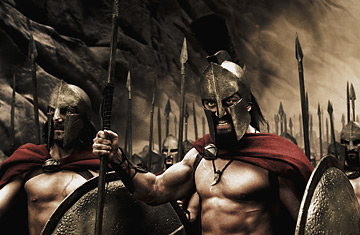
300: March to Glory.
(2 of 2)
The result is a gorgeous, dreamlike movie that's almost too perfect. Every frame is neat and composed, like an oil painting, not a hair or a grain of sand out of place. All noise and dissonance have been digitally eliminated. It's beautiful, but it's more beautiful than it is real. Movies are invigorated by the tension between the director and reality, the struggle of the artist to tame the reluctant, intractable world, and that tension is missing from 300. If you've ever seen Hearts of Darkness, the documentary of the disastrous campaign to make a very different war movie, Apocalypse Now, you've heard Francis Ford Coppola say: "My movie is not about Vietnam. My movie is Vietnam." Coppola's protracted, Pyrrhic struggle against the jungle stokes the movie's crazy energy. In 300 there's not really much of a struggle. If 300 is the Battle of Thermopylae, then Snyder is the digital god-king Xerxes, and not the Spartans.
In Snyder's defense, 300 isn't really a movie about a battle at all. It's a movie about a graphic novel about a movie about a battle. "It's not trying to be reality," Snyder says. "The blood is treated like paint, like paint on a canvas. It's not Saving Private Ryan. It's something else." Maybe that's the only way to make a war movie right now, or at least, the only way to make a war movie that's not an antiwar movie. 300 turns the ugliest human spectacle imaginable into something beautiful, and it's to the movie's credit that it doesn't confuse what it's doing with anything real. Onscreen, death actually has meaning that it often lacks in life. Conflict isn't complicated. Motivation is clear. "With 300, the why is obvious," Snyder says, "and that's a thing that maybe doesn't even exist in real life. Maybe when it happened it wasn't even that clear. That's why it's a piece of mythology. It's what we would hope for." 300 is a vision of war as ennobling and morally unambiguous and spectacularly good-looking. That's one hell of a special effect.
